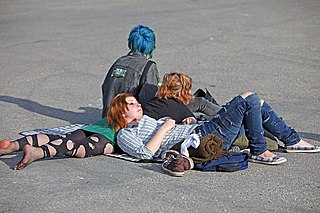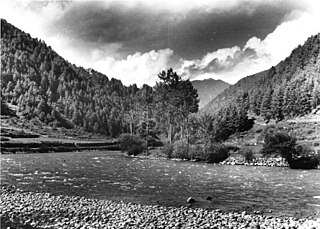Related Research Articles

Bi-curious is a term for a person, usually someone who is a self-identified heterosexual, who is curious or open about engaging in sexual activity with a person whose sex differs from that of their usual sexual partners. The term is sometimes used to describe a broad continuum of sexual orientation between heterosexuality and bisexuality. Such continuums include mostly heterosexual or mostly homosexual, but these can be self-identified without identifying as bisexual. The terms heteroflexible and homoflexible are mainly applied to bi-curious people, though some authors distinguish heteroflexibility and homoflexibility as lacking the "wish to experiment with sexuality" implied by the bi-curious label. It is important when discussing this continuum to conclude that bisexuality is distinct from heterosexuality and homosexuality rather than simply an extension of said sexualities like the labels heteroflexibility and homoflexibility would imply, due to the prominent erasure and assimilation of bisexuality into other identity groups. To sum it up, the difference between bisexual and bicurious is that bisexual people know that they are sexually attracted to both genders based on personal experience. Bicurious people are still maneuvering their way through their sexuality.
Religious philosophy is philosophical thinking that is influenced and directed as a consequence of teachings from a particular religion. It can be done objectively, but it may also be done as a persuasion tool by believers in that faith. Religious philosophy is concerned with the nature of religion, theories of salvation, and conceptions of god, gods, and/or the divine.

Cultural identity is a part of a person's identity, or their self-conception and self-perception, and is related to nationality, ethnicity, religion, social class, generation, locality, gender, or any kind of social group that has its own distinct culture. In this way, cultural identity is both characteristic of the individual but also of the culturally identical group of members sharing the same cultural identity or upbringing. Cultural identity is a unfixed process that is continually evolving within the discourses of social, cultural, and historical experiences. Some people undergo more cultural identity changes as opposed to others, those who change less often have a clear cultural identity. This means that they have a dynamic yet stable integration of their culture.
A colonial mentality is the internalized attitude of ethnic or cultural inferiority felt by people as a result of colonization, i.e. them being colonized by another group. It corresponds with the belief that the cultural values of the colonizer are inherently superior to one's own. The term has been used by postcolonial scholars to discuss the transgenerational effects of colonialism present in former colonies following decolonization. It is commonly used as an operational concept for framing ideological domination in historical colonial experiences. In psychology colonial mentality has been used to explain instances of collective depression, anxiety, and other widespread mental health issues in populations that have experienced colonization.

Siliguri is a major tier-II city in West Bengal. It forms "Twin Cities" with the neighbouring district capital of Jalpaiguri. The city spans areas of the Darjeeling and Jalpaiguri districts in the Indian state of West Bengal. Known as the "Gateway of Northeast India", Siliguri is popular for three Ts: tea, timber and tourism. It is located on the banks of the Mahananda River and the Teesta River at the foothills of the Himalayas. Siliguri is the third largest urban agglomeration in West Bengal, after Kolkata and Asansol.

The Siliguri Corridor, also known as the Chicken's Neck, is a stretch of land around the city of Siliguri in West Bengal, India. 20–22 kilometres (12–14 mi) at the narrowest section, this geo-political and geo-economical corridor connects the eight states of northeast India to the rest of the Indian Republic. The countries of Nepal and Bangladesh lie on each side of the corridor and the Kingdom of Bhutan lies at the northern end of the corridor. The Kingdom of Sikkim formerly lay on the northern side of the corridor, until its merging with India in 1975.
In justifying opening up and the series of economic reforms that ensued in China, Deng Xiaoping referred to Karl Marx and his theories, which predicted that nations need to undergo urbanization and a stage of capitalism for a natural socialist transition. One of the most renowned reforms under Deng was establishing four "special economic zones" along the Southeastern coast of China, with Shenzhen, Shantou, and Zhuhai located in Guangdong province and Xiamen located in Fujian province. The four aforementioned special economic zones were all established from 1980 to 1981. As of 2024, there have been 3 additional special economic zones. In 1988, Hainan became the fifth "SEZ". In 1990, Pudong district in Shanghai became the sixth "SEZ". In 2009, Binhai district in Tianjin became the seventh "SEZ". Special economic zones (SEZs) in mainland China are granted more free market-oriented economic policies and flexible governmental measures by the government of China, compared to the planned economy elsewhere.

The Bamar are a Southeast Asian ethnic group native to Myanmar. They are a Tibeto-Burman ethnic group of approximately 35 million people who constitute Myanmar's largest ethnic group, accounting for 68% of the country's population. The geographic homeland of the Bamar is the Irrawaddy River basin. The Bamar speak the Burmese language which serves as the national language and lingua franca of Myanmar.
India has developed its discourse on sexuality differently based on its distinct regions with their own unique cultures. According to R.P. Bhatia, a New Delhi psychoanalyst and psychotherapist, middle-class India's "very strong repressive attitude" has made it impossible for many married couples to function well sexually, or even to function at all.

The Chumbi Valley, called Dromo or Tromo in Tibetan, is a valley in the Himalayas that projects southwards from the Tibetan plateau, intervening between Sikkim and Bhutan. It is coextensive with the administrative unit Yadong County in the Tibet Autonomous Region of China. The Chumbi Valley is connected to Sikkim to the southwest via the mountain passes of Nathu La and Jelep La.
Limited English proficiency (LEP) is a term used in the United States that refers to a person who is not fluent in the English language, often because it is not their native language. Both LEP and English-language learner (ELL) are terms used by the Office for Civil Rights, a sub-agency of the U.S. Department of Education.

Forensic social work is the application of social work to questions and issues relating to the law and legal systems. It is a type of social work that involves the application of social work principles and practices in legal, criminal, and civil contexts. It is a specialized branch of social work that focuses on the intersection of law and mental health. Forensic social work is an important part of the criminal justice system and provides an important link between mental health and the legal system.
Ethnic relations in India have historically been complex. India is ethnically diverse, with more than 2,000 different ethnic groups. There is also significant diversity within regions, and almost every state and several districts has its own distinct mixture of ethnicities, traditions, and culture. Throughout the history of India, ethnic relations have been both positive and negative.

The Isan people or literally Northeastern people are an ethnic group native to Northeastern Thailand with an estimated population of about 22 million. Alternative terms for this group are T(h)ai Isan, Thai-Lao, Lao Isan, or Isan Lao. Like Central Thai (Siamese) and Lao, they belong to the linguistic family of Tai peoples.
Anne Alexandra Lawrence is an American psychologist, sexologist, and former anesthesiologist who has published extensively on gender incongruence. Anne transitioned male to female in her 40s.
Transgender health care includes the prevention, diagnosis and treatment of physical and mental health conditions, as well as sex reassignment therapies, for transgender individuals. A major component of transgender health care is gender-affirming care, the medical aspect of gender transition. Questions implicated in transgender health care include gender variance, sex reassignment therapy, health risks, and access to healthcare for trans people in different countries around the world.

Intersex people are born with sex characteristics that "do not fit the typical definitions for male or female bodies". They are substantially more likely to identify as lesbian, gay, bisexual, or transgender (LGBT) than endosex people, an estimated 52% identifying as non-heterosexual and 8.5% to 20% experiencing gender dysphoria. Although many intersex people are heterosexual and cisgender, this overlap and "shared experiences of harm arising from dominant societal sex and gender norms" has led to intersex people often being included under the LGBT umbrella, with the acronym sometimes expanded to LGBTI. Some intersex activists and organisations have criticised this inclusion as distracting from intersex-specific issues such as involuntary medical interventions.

Intersex people are born with natural variations in physical and sex characteristics including those of the chromosomes, gonads, sex hormones, or genitals that, according to the UN Office of the High Commissioner for Human Rights, "do not fit the typical definitions for male or female bodies". Such variations may involve genital ambiguity, and combinations of chromosomal genotype and sexual phenotype other than XY-male and XX-female. Preimplantation genetic diagnosis allows the elimination of embryos and fetuses with intersex traits and thus has an impact on discrimination against intersex people.

Meitei nationalism refers to nationalism among the Meitei people. In the Meitei context this includes various movements throughout history to sustain Meitei cultural identity, political boundary, ethnicity and history to regain sovereign state status of Kangleipak.
References
- ↑ McDuie-Ra, Duncan (2016-07-02). "Adjacent identities in Northeast India". Asian Ethnicity. 17 (3): 400–413. doi:10.1080/14631369.2015.1091654. ISSN 1463-1369.
- ↑ Malik, Hasan Yaser (February 2015). "Siliguri: A Geopolitical Manoeuvre Corridor in the Eastern Himalayan Region for China and India": 699–VIII.
{{cite journal}}: Cite journal requires|journal=(help) - 1 2 Dutta, Urmitapa (February 2015). "The Long Way Home: The Vicissitudes of Belonging and Otherness in Northeast India". Qualitative Inquiry. 21 (2): 161–172. doi:10.1177/1077800414542703. ISSN 1077-8004.
- ↑ Goswami, Uddipana (2019). "Armed in Northeast India: Special Powers, Act or No Act".
{{cite journal}}: Cite journal requires|journal=(help) - ↑ Haokip, Thongkholal (2011-08-01), Conceptualising Northeast India: A Discursive Analysis on Diversity (SSRN Scholarly Paper), Rochester, NY, retrieved 2024-02-13
{{citation}}: CS1 maint: location missing publisher (link) - ↑ Hennig, Thomas (2015). "Energy, Hydropower, and Geopolitics — Northeast India and its Neighbors: A Critical Review of the Establishment of India's Largest Hydropower Base". ASIEN: The German Journal on Contemporary Asia (134): 121–142. doi:10.11588/asien.2015.134.18889. ISSN 2701-8431.
- ↑ Gogoi, Meghali (2019-03-31). "Rethinking the Problematics of Identity in Northeast India with Special Reference to Temsula Ao's These Hills Called Home: Stories from a War Zone and Laburnum for my Head: A Discourse of Cultural Recovery". International Journal of Applied Linguistics and English Literature. 8 (2): 177–180. doi:10.7575/aiac.ijalel.v.8n.2p.177. ISSN 2200-3452.
- ↑ Marbaniang, Strong P. (2023-04-03). "Women Care and Practices in the Management of Childhood Diarrhea in Northeast India". Child Care in Practice. 29 (2): 139–151. doi:10.1080/13575279.2020.1812534. ISSN 1357-5279.